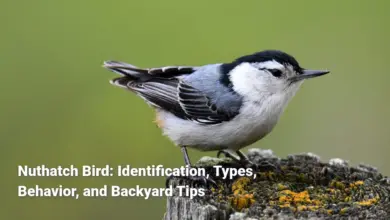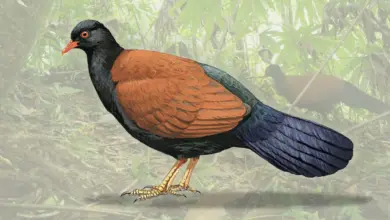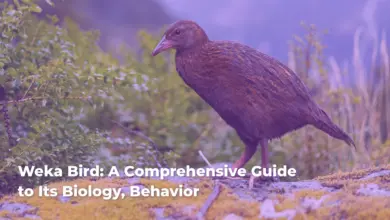Male Ducks: Characteristics, Behavior, and Role in Ecosystems
An In-Depth Look at the Unique Traits, Behaviors, and Ecological Importance of Male Ducks
Male Duck
The world of male ducks is as varied and vibrant as their plumage suggests. These fascinating waterfowl, known colloquially as drakes, play an integral role in their ecosystems, not only through their unique behaviors but also as symbols in cultural narratives worldwide. Male ducks captivate observers with their colorful appearances, mating rituals, and territorial behaviors, reflecting the complex dynamics of the avian world. As we delve into their physical characteristics, behavior, habitat preferences, diet, species diversity, ecological importance, and cultural significance, we uncover how these creatures are much more than just charming figures in our parks and ponds.
From the swamps and marshes to urban parks, male ducks exhibit a rich tapestry of traits and adaptations that are crucial for their survival and reproduction. The vibrant spectrum of colors in male ducks is not just for show; it’s a tool for attracting mates and establishing dominance during breeding season. Moreover, their diverse diets and feeding habits exhibit their adaptability to different environments. Understanding these aspects of male ducks can enrich our appreciation for them and highlight the crucial role they play in ecological systems and human culture alike.
Physical Characteristics of Male Ducks
Male ducks, also known as drakes, are recognized for their striking physical features, which often set them apart from their female counterparts. This sexual dimorphism is vividly illustrated through their plumage, size, and other notable attributes. At first glance, a male duck can be likened to a flamboyant performer on a stage, using its appearance to attract admiring audiences.
- Plumage and Coloration: One of the most remarkable characteristics of male ducks is their vibrant plumage. For instance, male Mallards exhibit a green head, chestnut-brown breast, and gray body, showcasing a stunning color palette that starkly contrasts with the more muted browns of the females. This visual distinction plays a key role during the mating season, as bright colors are more effective at attracting females looking for healthy mates.
- Size and Weight: Generally, male ducks are larger than females, with lengths that vary by species. For example, drakes can range anywhere from 20 to 25 inches, with weights fluctuating significantly based on breeding and environmental factors. A male Pekin duck can weigh in at an impressive 7 to 10 pounds, demonstrating the vast size differences across duck species.
- Curly Tail Feathers: Another distinguishing feature in male ducks is the presence of curly tail feathers, often referred to as “drake feathers.” These feathers are typically more pronounced during the breeding season and serve as an additional sign of maturity and health, further attracting potential mates.
- Bill Diversity: The size and shape of bills also vary among male ducks. For instance, Northern Shovelers are known for their large, shovel-like bills, which are adapted for their unique feeding methods. A broad bill can help facilitate effective foraging, underscoring the relationship between a male’s physical characteristics and its feeding habits.
- Seasonal Changes: Interestingly, male ducks undergo plumage transformations as seasons change. During the non-breeding season, many shift to a more understated plumage resembling that of females, helping them to evade predators. This adaptation reflects the dynamic nature of their survival strategies.
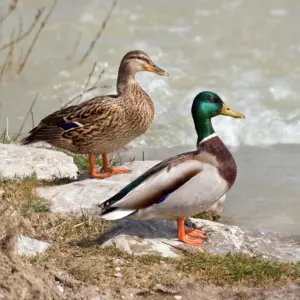
In conclusion, the physical characteristics of male ducks not only serve aesthetic purposes but also play critical roles in their survival and reproduction. Their plumage, size, bill shape, and even their unique historical adaptations illustrate the incredible specificity and diversity found within this fascinating avian group.
Plumage and Coloration
Male ducks are renowned for their plumage and coloration, which serve not only utility in mating but also for species recognition. This vibrant appearance is akin to a painter’s palette brimming with vivid colors designed to catch the eye, creating a stunning outdoor vista.
- Sexual Dimorphism: Male ducks exhibit striking color differences from their female counterparts, which typically possess more muted tones. This phenomenon, dubbed sexual dimorphism, plays a crucial role in attracting potential mates. For instance, a male Wood Duck is resplendent with metallic green heads and brilliant red accents, while the female is primarily grey-brown, camouflaging her effectively from predators.
- Courtship Displays: During courtship, male ducks flaunt their colorful plumage in elaborate displays, often performed in shallow waters. By extending their wings or performing head shakes, they accentuate their vibrant feathers, thus signaling their health and vitality to potential mates.
- Seasonal Plumage Change: Besides the vivid colors seen during breeding seasons, many male ducks will undergo molting post-season, resulting in duller coloring that mimics females. This seasonal change acts as a built-in camouflage mechanism, protecting them from predators until the next breeding cycle.
- Species Variability: Diverse species of male ducks flaunt unique plumage patterns and gradients, from the striking colors of the Mandarin Duck to the subtle yet intricate design of the Northern Pintail. Each species illustrates the evolutionary adaptations within their specific habitats that favor distinct coloration and patterns for reproduction and survival.
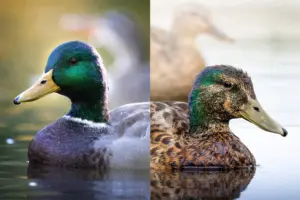
In summary, the plumage and coloration of male ducks are not merely aesthetic; they are integral to mating success, survival tactics, and ecological adaptation. Their striking appearances enhance species visibility and importance within both natural and human-influenced environments.
Size and Weight
The size and weight of male ducks vary significantly across species, reflecting adaptations to their environments and lifestyles. Understanding these physical attributes is crucial for identifying different species as well as for insights into their behaviors and ecological roles.
- Typical Sizes: Male ducks generally range in size from about 20 to 25 inches in length, with variations depending on species. For instance, a male Mallard typically measures 20 to 26 inches, whereas larger breeds like the Pekin can reach lengths of up to 30 inches. This size difference affects their mobility and feeding habits, as larger ducks can access different resources compared to smaller species.
- Weight Variations: In terms of weight, male ducks can range from as light as 2.5 pounds for smaller species to as much as 10 pounds for larger, domesticated breeds such as the Pekin. The average weight for a male Mallard ranges from 3 to 4.5 pounds, which is quite manageable for flight yet substantial enough to provide resilience against predators.
- Body Structure: Duck body structures exhibit adaptations for their specific lifestyles. For example, diving ducks typically have more compact and heavier bodies suited for swimming and diving, whereas dabbling ducks, like the Northern Pintail, are more elongated and lightweight. This structural adaptation allows each species to exploit different environments and food sources effectively.
- Sexual Dimorphism: Weight differences also support the notion of sexual dimorphism, with male ducks generally being heavier than females in some species. This weight gives males a competitive edge during territorial displays and courtship, contributing to their overall mating success.
Thus, the size and weight of male ducks reflect their adaptive strategies, mating success, and ecological roles in their habitats. Understanding these characteristics enhances our appreciation of the diversity among waterfowl and their ability to thrive in various environments.
Behavior of Male Ducks
Male ducks exhibit a range of engaging behaviors that reflect their social structures and mating strategies. Understanding these behaviors is essential for anyone interested in the complexities of their life cycle, providing insight into their natural instincts and the roles they play within their communities.
- Vocalization Patterns: Male ducks develop distinct vocal patterns, generally consisting of lower, raspier calls compared to the quacking of females. These vocalizations serve multiple functions, such as marking territory, attracting mates, or signaling distress. Observing these calls can provide clues about the social dynamics within a flock.
- Courtship Displays: During mating season, male ducks engage in elaborate courtship displays to attract females. This may include head bobbing, tail wagging, or splashing water towards the female. Such behaviors not only demonstrate the male’s vigor but also assert his dominance within a competitive breeding environment.
- Aggression and Territoriality: Males display notable aggression during the breeding season, often fiercely defending their territory against other males. This behavior ensures that they have access to potential mates, with dominant males generally securing more breeding opportunities. These encounters can escalate into physical confrontations, highlighting the competitive nature of their breeding season.
- Social Structure Dynamics: Within a flock, male ducks establish a social hierarchy based on size, strength, and displays of dominance. More dominant males tend to have better access to resources and mates, showcasing a clear relationship between behavior, social structure, and reproductive success.
- Mating Practices: Mating involvement can often be aggressive, with males grasping the females by the neck or using forceful mounts. These practices can appear ritualistic but are critical for ensuring successful copulation, and each species has unique mating intricacies.
Taken together, the behaviors exhibited by male ducks not only define their reproductive strategies but also highlight the adaptiveness and complexity of their social interactions. Observing these behaviors provides a window into the social musings and intricate relationships within the duck world.
Mating Rituals and Courtship
Mating rituals and courtship behaviors among male ducks are intricate displays of attraction and competition that reflect the species’ specific reproductive strategies. These behaviors serve as crucial components in the mating success of drakes, showcasing both their physical prowess and adaptability.
- Elaborate Displays: During courtship, male ducks engage in elaborate rituals, displaying their physical attributes, particularly their vibrant plumage. Males may perform a range of movements, such as head bobbing, water splashing, and preening, all designed to catch the attention of potential female mates. These displays often occur in shallow waters, allowing for the full display of their flamboyant feathers.
- Vocal Signals: Male ducks produce distinct vocalizations during courtship, which vary between species. Some drakes may emit soft quacking or whistling sounds to convey their interest. These vocal signals are also crucial for establishing territory; the louder and more distinctive the call, the more likely the male is to attract attention while warding off competitors.
- Body Posturing: The physical movements involved in courtship are ritualized and can include tail wagging, head shaking, and wing flapping. These actions are designed to demonstrate health and vitality, making the drake more appealing to potential mates. Moreover, how a male duck carries himself can indicate his dominance among peers, which plays a role in mate selection.
- Aggressive Mating Behavior: While the courtship process is colorful and engaging, it can also be aggressive. Male ducks often grasp the female’s neck during mating as a means of stabilization, an essential practice for successful copulation. Understanding this aggression helps contextualize the behavior within a larger framework of natural selection stronger males are often more successful in securing mates.
- Monogamous Bonds: Interestingly, many duck species exhibit levels of monogamy during breeding seasons, forming strong bonds that can last through the incubation period. Despite this temporary pairing, males often seek new partners in subsequent seasons, indicating a mix of fidelity and opportunism in their mating strategies.
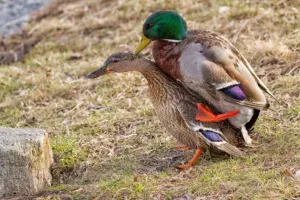
In conclusion, the mating rituals and courtship behaviors of male ducks encapsulate the striking interplay between display, competition, and reproductive success. Through engaging in elaborate courtship, vocalizations, and sometimes aggressive mating behaviors, male drakes navigate the complexities of attracting females, securing their lineage in the process.
Territorial Behavior
The territorial behavior of male ducks plays a pivotal role in their reproductive success and overall survival. Understanding these behaviors provides insight into their social dynamics, mating opportunities, and ecological interactions.
- Establishing Territories: As males enter the breeding season, they become notably territorial, establishing boundaries around their preferred nesting and feeding sites. These territories generally encompass areas rich in resources, from food supplies to potential nesting locations. Territorial displays often commence with vocalizations and physical posturing to warn other males of their presence.
- Aggression and Defense: Often, males will engage in aggressive behaviors to defend their territories, which can include physical confrontations with other drakes. These confrontations may be resolved through displays of dominance such as aggressive vocalizations or physical posturing rather than actual fighting. However, disputes can escalate into serious encounters when two males vie for the same prime territory.
- Attracting Mates: Territoriality not only serves to fend off rival males but also to attract females. A well-established and defended territory reflects a male’s fitness and ability to provide for potential mates and offspring. Consequently, females are more likely to choose males based on the quality of their territories.
- Seasonal Dynamics: This behavior can shift seasonally; as the mating season progresses, competition for territories often becomes more intense. Once pair bonds are formed, males may relax their territorial aggressiveness, focusing instead on the protection of their nests and offspring.
- Ecological Impact: The territorial behavior of male ducks has broader implications for their ecosystems. By defending specific areas, they play a role in regulating populations of various aquatic plants and invertebrates, which can shape the ecological landscape and influence the biodiversity within their shared environments.
In summary, the territorial behavior of male ducks is a complex interplay of aggression, attraction, and ecological impact. Understanding these dynamics not only enhances our appreciation for these fascinating waterfowl but also reflects the intricate balance of species interactions within their habitats.
Habitat Preferences for Male Ducks
The habitat preferences of male ducks are influenced by a variety of factors, including the availability of resources, safety from predators, and breeding needs. These preferences highlight the adaptability of male ducks to various environments while underscoring the importance of specific habitats for their survival and reproductive success.
- Wetland Dependence: Male ducks primarily thrive in wetland environments, including marshes, lakes, ponds, rivers, and estuaries. These ecosystems provide abundant food sources and suitable nesting sites for females during the breeding season. The availability of shallow waters rich in aquatic vegetation makes wetland habitats ideal for both foraging and breeding.
- Water Depth Requirements: Many male ducks prefer shallow waters typically less than three feet deep which facilitate easy access to food. Such environments host diverse plant life and aquatic invertebrates that provide essential nutrition. The shallow depths also allow for easy courtship displays, critical during mating season.
- Concealment Needs: During breeding season, male ducks often gravitate towards habitats that offer adequate cover from predators. Dense vegetation not only provides hiding spots while the males engage in courtship displays but also protects their nests from potential threats. This need for concealment underscores the importance of habitat structure in successful reproduction.
- Urban Adaptability: Interestingly, many male ducks, particularly the Mallard, are highly adaptable and can thrive in both natural and urban environments. They are frequently spotted in city parks, ponds, and agricultural areas, where human-created habitats provide access to food and water. This adaptability highlights their resilience in changing landscapes.
- Proximity to Nesting Sites: Male ducks typically remain in proximity to the nesting areas chosen by their female counterparts. Nests are usually built in dense cover near water, allowing males to provide protection and support during the breeding period. Nesting successes often depend on the quality of the surrounding habitat, emphasizing the connection between male habitat preferences and reproductive outcomes.
Overall, the habitat preferences of male ducks reveal their strong dependency on wetlands for survival and reproductive success. Understanding these preferences informs conservation efforts aimed at protecting vital ecosystems that sustain diverse wildlife populations.
Preferred Environments
The preferred environments of male ducks are intimately connected to their survival and reproduction. By analyzing the habitats they choose, we can develop a clearer understanding of the ecological requirements that support healthy male duck populations.
- Wetland Environments: Male ducks primarily inhabit wetland ecosystems, including marshes, lakes, and ponds. These areas provide ample food sources such as aquatic vegetation and invertebrates, essential for both foraging and nutrition throughout the year. The shallow nature of wetlands allows for easy access to food and breeding supports.
- Shallow Waters: Ducks often favor shallow waters, generally less than three feet deep, which allow access to a variety of food sources without the need for extensive diving. This depth profile is crucial for their feeding behavior, where they dabble or tip forward to forage for plants and invertebrates.
- Habitat Cover: Dense vegetation within wetland habitats is vital for male ducks during the breeding season. It not only provides cover from potential predators but also serves as a staging area for courtship displays and nesting. Male ducks often rely on these areas to perform elaborate mating rituals safely.
- Urban Adaptability: Interestingly, many male duck species, particularly the ubiquitous Mallard, display resilience by adapting to urban environments. City parks, quiet lakes, and artificial ponds serve as alternative habitat options, allowing these birds to thrive even in human-dominated landscapes.
- Ecological Diversity Impact: The selection of preferred environments directly influences ecological diversity. By favoring wetlands and shallow waters, male ducks contribute to nutrient cycling and vegetation control, which leads to the overall health of these ecosystems.
In conclusion, the preferred environments of male ducks illuminate the necessity of wetlands as critical habitats. Preserving and restoring these environments is imperative for maintaining healthy and diverse populations of male ducks, as well as the ecosystems they inhabit.
Nesting Locations
The nesting locations selected by male ducks, particularly those of species that engage in territory defense and courtship, play an essential role in their reproductive success. Understanding these locations sheds light on the adaptations and strategies that male ducks utilize for successfully raising their offspring.
- Cavity Nesting: Some species, like the Wood Duck, prefer to nest in tree cavities situated close to water sources such as ponds and swamps. These cavities offer protection from predators and harsh weather, significantly increasing the odds of survival for ducklings after they hatch. The competition for suitable cavity nesting sites reflects the high stakes of reproductive success in many duck populations.
- Upland and Overwater Nesting: Other duck species, such as the Mallard and Northern Pintail, nest on dry land within dense vegetation near shallow wetlands. This upland nesting approach allows for additional protection against predators. Overwater-nesting species like Redheads often build nests on floating mats of vegetation, ensuring accessibility to food and safety from ground-based threats.
- Nest Site Selection: The selection of specific nesting sites can dramatically affect the survival of both the female and her eggs. Poor nesting site choices leave eggs vulnerable to predation and environmental conditions. Research has demonstrated that male ducks often assist in selecting nesting sites, showcasing their role in reproductive strategies and collective decision-making.
- Nest Proximity to Resources: Male ducks typically remain close to the nesting areas chosen by females, ensuring that they can provide adequate protection and resources. The proximity to food and water sources near the nesting site is critical for sustaining both female adults and their developing ducklings.
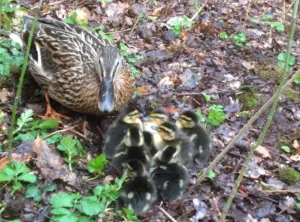
Moreover, male ducks have shown an adaptive capacity in their nesting behaviors, influenced by environmental pressures and ecological changes. Monitoring their nesting habits can provide valuable insight into population health and overall habitat quality.
Diet of Male Ducks
The diet of male ducks is predominantly omnivorous, reflecting their adaptability to various environments and the seasonal availability of food sources. Understanding their dietary preferences and feeding habits is vital for comprehending their ecological roles and ensuring adequate habitat conservation.
- Varied Diet Composition: Male ducks consume a diverse range of foods, including invertebrates, aquatic plants, seeds, grains, and occasionally fruits. For example, during breeding seasons, they focus on high-protein foods like aquatic invertebrates, which are crucial for supporting the energy needs of both themselves and their mates.
- Foraging Behavior: Male ducks exhibit strong foraging instincts, using their broad, flat bills to filter food from the water. This dabbling behavior enables them to reach aquatic vegetation while also consuming small invertebrates found in wet mud or shallow waters. In contrast, diving ducks may utilize different strategies, often submerging themselves to forage for fish or crustaceans.
- Grazing Habits: On land, male ducks can often be observed grazing on grass and other green vegetation. This behavior provides not only sustenance but also promotes healthy digestive processes. Grazing is a vital part of their feeding habits, particularly in habitats where aquatic food sources may be scarce.
- Social Feeding Groups: Male ducks often feed in groups, a behavior that enhances foraging efficiency and safety from predators. This social behavior allows them to collectively locate food sources while also maximizing their chances of survival during vulnerable feeding times.
- Seasonal Variations: Male ducks’ diets fluctuate according to the season, with significant shifts occurring during migration periods. During the winter months, their diet typically includes more carbohydrate-rich foods, such as agricultural crops, to build fat reserves necessary for energy during long migratory flights.
Ultimately, the diet of male ducks reflects their adaptability and ecological importance within wetland environments. Their omnivorous feeding habits allow them to thrive in varied ecosystems while contributing to nutrient cycling and maintaining the balance of aquatic and terrestrial plant growth.
Types of Food Consumed
Male ducks exhibit a diverse diet that varies by species and seasonal availability of food sources. Understanding the types of food consumed by these fascinating waterfowl provides insight into their ecological contributions and dietary adaptations.
- Aquatic Invertebrates: A significant portion of a male duck’s diet includes aquatic invertebrates such as snails, insects, and worms. These protein-rich foods are crucial for growth and reproduction, specially required during breeding seasons when males need high energy levels for courtship displays and mate support.
- Aquatic Plants: Male ducks feed extensively on a variety of aquatic vegetation, including duckweed, water lilies, and other submerged or floating plants. Plant matter not only sustains them but also promotes a healthy digestive process, contributing to their overall well-being.
- Seeds and Grains: Wild grasses and seeds feature prominently in their diet, particularly during migrations. Male ducks often forage in agricultural fields, consuming crops like rice, corn, and other grains that serve as vital energy sources, especially in preparation for breeding.
- Fish and Small Aquatic Animals: Some male duck species, especially diving ducks, are known to consume small fish and crustaceans. This foraging behavior helps them supplement their protein intake, further highlighting the dietary flexibility of male ducks.
- Fruits and Vegetables: Ducks occasionally enjoy berries, melons, and leafy greens when accessible. In domestic contexts, these items can be offered as treats, enhancing the nutritional variety in their diets.
Understanding the types of food consumed by male ducks underscores their dietary diversity and adaptability. This adaptability allows them to occupy various ecological niches and demonstrates the need for a wide range of habitats to support their complex feeding behaviors.
Feeding Habits
The feeding habits of male ducks are integral to their survival, reproductive success, and broader ecological roles. These habits reflect their adaptability, resourcefulness, and the unique dietary requirements of various duck species.
- Foraging Techniques: Male ducks employ distinct foraging techniques tailored to their feeding preferences. Dabbling ducks, such as the Mallard, tip their bodies forward in shallow water to access both aquatic plants and invertebrates. This behavior allows them to effectively filter food while maintaining buoyancy.
- Grazing Behavior: On land, male ducks are often observed grazing on grasses and green vegetation. This grazing habit not only sustains their energy levels but also contributes to soil health by controlling plant growth. Their foraging behavior helps maintain a balanced ecosystem within their habitats.
- Group Feeding Behavior: Male ducks frequently engage in social feeding, often gathering in groups to locate food sources. This collective behavior enhances feeding efficiency and provides safety in numbers, which is crucial, especially in environments where predators are present.
- Seasonal Dietary Shifts: As seasons change, male ducks adjust their feeding habits in response to fluctuations in food availability. During the breeding season, they tend to increase their intake of protein-rich foods to support egg production despite males not laying eggs themselves. In contrast, during migration, their diet may shift towards carbohydrate-rich foods to prepare for long flights.
- Human Influences on Feeding: In domestic settings, male ducks are often provided a balanced diet consisting of commercial duck feed, along with supplements like fruits and vegetables. This balanced diet is crucial for maintaining their health and meeting their nutritional needs, allowing them to thrive in artificial environments.
Overall, the feeding habits of male ducks reveal their adaptability, resourcefulness, and ecological importance. Their varied diets and foraging techniques highlight the necessity of diverse habitats to support healthy duck populations and sustainable ecosystems.
Species of Male Ducks
The world is home to numerous species of male ducks, each with unique characteristics and adaptations that cater to their specific habitats and lifestyles. Understanding the diversity among these drakes can enhance our appreciation and knowledge of these captivating waterfowl.
- Mallard Duck (Anas platyrhynchos): Undoubtedly one of the most recognizable duck species, male Mallards are celebrated for their vibrant green heads, white neck rings, and chestnut-brown breasts. These adaptable birds inhabit a wide range of environments, from freshwater to urban parks, often dabbling and tipping in shallow waters to forage for food.
- Wood Duck (Aix sponsa): Often regarded as one of the most beautiful ducks, male Wood Ducks possess stunning metallic green plumage with striking markings. Preferring wooded swamp areas, they nest in tree cavities, showcasing their unique adaptation to avoid ground predators while providing for their young.
- Mandarin Duck (Aix galericulata): Renowned for their dazzling coloration, male Mandarin Ducks feature distinctive orange ‘sails’ on their backs and intricate patterns of blue, green, and white feathers. Native to East Asia, they thrive in wooded habitats near water, often nesting in tree cavities.
- Northern Shoveler (Anas clypeata): Male Northern Shovelers are easily identifiable by their large, shovel-shaped bills and striking green heads. These dabbling ducks prefer shallow wetlands and utilize their unique bills to efficiently filter food from the water, showcasing their distinct feeding adaptations.
- Redhead Duck (Aythya americana): Male Redhead Ducks are known for their striking red heads and rounded silhouette. They inhabit freshwater marshes and ponds, where they dive for subaqueous vegetation and invertebrates, revealing their capacity for foraging.
- Common Eider (Somateria mollissima): Notable for their black and white plumage with a distinctive green nape, male Common Eiders are sea ducks found along northern coastlines. Their diving abilities enable them to hunt for mollusks and crustaceans in marine environments.
- Harlequin Duck (Histrionicus histrionicus): Brightly colored males feature intricate patterns of blue, white, and chestnut–a visual symphony that catches the eye. Preferring rugged coastal waters, they showcase strong swimming and diving abilities as they feed on invertebrates.
These diverse species of male ducks not only highlight the physical and behavioral adaptations necessary for survival in varied ecosystems but also enrich our understanding of avian biodiversity. Each species plays a vital role in their respective habitats and contributes to the broader ecological balance.
Common Species Around the World
Across the globe, a range of common species of male ducks can be found, each exhibiting unique physical characteristics and behaviors. Familiarity with these species not only enhances our understanding of male ducks but also underscores the importance of preserving their habitats.
- Mallard Duck (Anas platyrhynchos):
- Distribution: Found in North America, Europe, and Asia.
- Appearance: Characterized by a green head, white neck ring, and brown chest.
- Habitat: Adaptable, inhabiting various freshwater environments, including urban areas.
- Wood Duck (Aix sponsa):
- Distribution: Native to North America, especially along wooded swamps and marshes.
- Appearance: Known for iridescent plumage, red eyes, and white throat patches.
- Habitat: Prefers tree cavities near water sources for nesting.
- Mandarin Duck (Aix galericulata):
- Distribution: Found primarily in East Asia, with some populations in Europe and North America.
- Appearance: Recognizable by their vibrant plumage and distinctive markings.
- Habitat: Inhabits wooded lakes and ponds.
- Northern Shoveler (Spatula clypeata):
- Distribution: Commonly seen in North America and parts of Europe and Asia.
- Appearance: Features a broad, shovel-like bill and striking green head.
- Habitat: Prefers shallow wetlands and marshes.
- Redhead Duck (Aythya americana):
- Distribution: Primarily found in North America, particularly in the interior regions.
- Appearance: Noted for its round red head, gray body, and black chest.
- Habitat: Inhabits freshwater marshes and ponds.
Understanding the common species of male ducks worldwide helps to foster conservation efforts, showcasing the need to protect their habitats to ensure the survival of these unique and intriguing birds. Each species contributes to the ecological balance and diversity, highlighting the importance of preserving their environments.
Unique Characteristics by Species
Each species of male ducks exhibits unique characteristics that contribute to their survival and reproductive success. Understanding these differences can provide valuable insights into avian ecology and the remarkable adaptations these birds possess.
- Canvasback Duck (Aythya valisineria):
- Unique Traits: Known for its sloping profile and narrow bill, the male canvasback features a striking red head and black chest.
- Feeding Adaptations: These ducks are excellent divers, often feeding on aquatic plants and invertebrates found on the lake or riverbed.
- Wood Duck (Aix sponsa):
- Unique Traits: Males showcase iridescent plumage of green, purple, and red, with a distinctive crested head.
- Nest Preferences: These ducks prefer nesting in tree cavities, providing safety from predators and easy access to nearby water sources.
- Common Eider (Somateria mollissima):
- Unique Traits: Recognizable by its black and white plumage and distinctive green nape, males have a robust build suited to marine environments.
- Feeding Habits: As sea ducks, they dive for mollusks and crustaceans, showcasing their strong swimming abilities.
- Redhead Duck (Aythya americana):
- Unique Traits: The male redhead features a rounded red head atop a gray body, with the coloration serving as excellent camouflage in marshy habitats.
- Diving Adaptability: These ducks are adept at diving for food, allowing them to access various aquatic plants and invertebrates.
- Harlequin Duck (Histrionicus histrionicus):
- Unique Traits: Males possess striking colorful patterns in blues, whites, and chestnuts, making them a visually spectacular sight.
- Habitat Preference: Preferred in fast-moving coastal waters, they are known for their swimming and diving prowess.
- Mandarin Duck (Aix galericulata):
- Unique Traits: Renowned for their striking and ornate plumage, male mandarin ducks possess vivid colors and intricate markings.
- Nesting Strategy: Relying on tree cavities for nesting, they avoid ground predators effectively, highlighting their adaptability.
These unique characteristics by species illustrate the diverse adaptations among male ducks, showcasing their ability to thrive in a variety of environments. Understanding these traits helps to inform conservation strategies and promote awareness of avian diversity.
Importance of Male Ducks in Ecosystems
The importance of male ducks in ecosystems extends beyond their charming displays and vibrant colors. As vital components within their ecological communities, these waterfowl play essential roles in maintaining the health of wetlands and contributing to biodiversity.
- Role in Biodiversity: Male ducks are critical for genetic diversity within their populations, as their courtship behaviors and displays influence mate selection. Healthy populations of male ducks are essential for maintaining ecological balance, ensuring adaptability and resilience in changing environments.
- Nutrient Cycling: As foragers, male ducks contribute to nutrient cycling by consuming aquatic plants and invertebrates, thus playing a role in the health of wetland ecosystems. Their feeding habits help manage plant growth and create a complex web of interactions within their habitats.
- Seed Dispersal: Duck species often consume seeds and fruits, acting as agents of seed dispersal in their ecosystems. This behavior fosters plant diversity and supports the growth of various flora within wetland settings, contributing to a robust ecological framework.
- Prey for Predators: Male ducks serve as prey for a variety of predators, including birds of prey and mammals. Their presence in food webs highlights their role as a food source, connecting disparate parts of the ecosystem and supporting various predator populations.
- Indicator Species: The health and viability of male duck populations can serve as indicators of ecosystem stability. Monitoring their populations and behaviors provides insights into potential environmental changes, emphasizing the need for ongoing conservation efforts in wetlands and aquatic habitats.
Overall, male ducks represent an integral part of ecosystem dynamics, emphasizing their roles in biodiversity, nutrient cycling, and as a food source for other species. Protecting their habitats is crucial for sustaining these vibrant birds and the ecological balance within their environments.
Role in Biodiversity
The role of male ducks in biodiversity is multifaceted and vital to the health and resilience of their ecosystems. Their behaviors, ecological contributions, and interactions with other species underscore their importance in maintaining the delicate balance of aquatic environments.
- Genetic Diversity: Male ducks contribute to genetic diversity within their populations through their courtship displays and territorial behaviors. Healthy populations encourage successful breeding, enhancing adaptability to environmental changes and promoting population resilience against diseases and climate-related challenges.
- Ecological Indicator Species: As inhabitants of wetland areas, male ducks can serve as indicators of ecosystem health. Their presence and behavior reflect the quality of their habitats an abundance of male ducks typically signifies a thriving ecosystem rich in resources. Monitoring changes in their populations can provide early warnings of environmental degradation.
- Diversity of Feeding Habitats: Male ducks engage in a wide range of foraging behaviors, which increases the diversity of species they interact with within their ecosystems. Their diet influences plant community structures, allowing for the coexistence of various plant species and contributing to overall ecosystem complexity.
- Interconnected Food Webs: By serving as both predators and prey, male ducks play an integral role in food webs. Their feeding habits help regulate populations of aquatic plants and invertebrates while providing sustenance for higher-level predators, creating a balanced ecological community.
- Niche Occupation: Various species of male ducks occupy different ecological niches, contributing to a rich tapestry of biodiversity. This niche differentiation allows for more effective resource utilization within the same ecosystem, minimizing competition and promoting coexistence.
In summary, the role of male ducks in biodiversity is crucial to the health and stability of their ecosystems. Their contributions to genetic diversity, as ecological indicators, and their interactions within food webs highlight the interconnectedness of species within wetland environments.保护重要栖息地以确保这些鸟类及其生态系统的健康。
Contribution to Food Chains
Male ducks serve a critical role in the food chains of their ecosystems, acting as both consumers and prey within complex trophic relationships. Their contributions are vital for maintaining balance and supporting a plethora of species in wetlands and aquatic environments.
- Primary Consumers: By consuming a variety of aquatic plants, seeds, and invertebrates, male ducks function as primary consumers. They help regulate plant growth and prevent overpopulation of certain species, which is essential for maintaining the health of their habitats.
- Influencing Aquatic Ecosystems: The feeding habits of male ducks can directly impact aquatic ecosystems. By foraging for invertebrates and plant matter, they contribute to nutrient cycling and promote biodiversity through seed dispersal, ultimately enhancing the complexity of their habitats.
- Prey for Higher-Level Predators: Male ducks are also important prey for various higher-level predators, including raptors, mammals, and larger fish. Their presence in food webs underscores their role in sustaining predator populations and maintaining the balance of the ecosystem.
- Ecological Indicators: Changes in male duck populations can signal shifts in ecosystem health, reflecting the availability of food resources and overall environmental conditions. Monitoring these populations allows ecologists to assess the stability of food chains and identify potential environmental threats.
- Carnivorous Diets in Some Species: While many male ducks are omnivorous, some species incorporate fish and invertebrates into their diets, thus acting as secondary consumers. Their diverse feeding strategies allow them to occupy various levels within food chains, showcasing the adaptability of male ducks in shifting environments.
In conclusion, the contribution of male ducks to food chains highlights their integral role in maintaining ecosystem dynamics. Their behaviors as primary consumers and prey demonstrate the interconnectedness of species within aquatic habitats and the necessity of preserving these environments for their ongoing health and resilience.
Cultural Significance of Male Ducks
Male ducks hold a rich tapestry of cultural significance across various societies and traditions, often embodying themes of love, loyalty, and adaptability. Through their representation in folklore, literature, and art, these birds serve as symbols that resonate with human experiences and values.
- Representation in Folklore and Literature: Many cultures feature male ducks in narratives and tales that convey moral lessons or cultural ideals. In Chinese culture, the Mandarin duck is a symbol of marital fidelity and happiness, often depicted in pairs to emphasize love and commitment. This representation solidifies their role as a reflection of the values related to romantic partnerships.
- Animal Symbolism: Male ducks are commonly associated with themes of adaptability and resilience. In Native American narratives, they serve as potent symbols of guidance and clarity, highlighting their connection to water and the lessons one can learn from nature. These attributes resonate deeply in many indigenous stories, strengthened through generations.
- Literary Involvement: In literature, male ducks appear as characters that embody growth and transformation. Hans Christian Andersen’s classic tale “The Ugly Duckling” serves as a prime example, indirectly referencing the male duck’s journey toward self-discovery and acceptance a theme that resonates with many human experiences of identity and personal growth.
- Artistic Representation: Male ducks have found their places in various art forms, often celebrated for their beauty and symbolism. In Chinese brush paintings, pairings of Mandarin ducks convey love, harmony, and fidelity. This vibrant representation bridges the world of nature with human emotion, encapsulating the spiritual connection between them.
- Ecological Significance: Beyond purely symbolic meanings, male ducks also come to embody the values of conservation and environmental stewardship. Their presence serves as a reminder of the importance of maintaining healthy ecosystems, promoting respect for nature and all living beings.
In summary, the cultural significance of male ducks is deeply rooted in themes of fidelity, adaptability, and personal growth. Their appearances in folklore, literature, and art illustrate the rich connections between human society and the natural world, as well as emphasizing the need for ecological awareness and conservation.
Representation in Folklore and Literature
Male ducks have been prominent figures in folklore and literature, often embodying values related to love, fidelity, and transformation. Their presence across various cultural narratives highlights the connection between humans and nature while conveying profound moral teachings.
- Marital Fidelity Symbolism: In cultures like Chinese folklore, male Mandarin ducks symbolize marital fidelity and happiness. Often depicted in pairs, they represent love and commitment, portraying the ideal of lifelong partnerships. This symbolism has made them popular motifs in art and storytelling, reinforcing the significance of romantic relationships.
- Transformational Narratives: In literary contexts, such as Hans Christian Andersen’s “The Ugly Duckling,” the male duck represents the journey of transformation from ostracism to acceptance. Through his struggles and eventual evolution, the narrative resonates with human experiences of identity and growth, emphasizing the value of self-acceptance in the face of adversity.
- Moral Lessons: Folklore frequently employs male ducks as vehicles for imparting moral lessons. Their behaviors often illustrate values such as resourcefulness, adaptability, and cooperation. By incorporating male ducks into traditional storytelling, cultures convey important lessons about balance, teamwork, and community.
- Ecological Connection: Beyond their moral implications, male ducks in folklore often serve as reminders of human interconnectedness with nature. Their lifestyle and behaviors reflect the importance of preserving aquatic habitats, reinforcing environmental stewardship in various cultural narratives.
- Cultural Rituals: In some cultures, male ducks may also be featured in rituals or celebrations, symbolizing abundance and fertility. Their migratory patterns and seasonal behaviors can inspire rhythmic practices that celebrate the cycles of life and nature.
Overall, the representation of male ducks in folklore and literature signifies a rich blend of cultural ideals, moral teachings, and connections to nature. These narratives enrich our understanding of these birds and the broader implications of their presence within human societal frameworks.
Male Ducks in Art and Media
Male ducks have made notable appearances in various forms of art and media, often representing themes of love, freedom, and the beauty of nature. Their striking appearances and engaging behaviors have inspired countless artists, filmmakers, and writers throughout history.
- Artistic Symbolism: In traditional art, particularly in Chinese brush paintings, male ducks, especially the Mandarin duck, symbolize love and fidelity. Depicted in pairs, their vibrant colors and intricate details evoke feelings of joy and partnership, transforming them into symbols of harmonious relationships. Such artworks enhance cultural appreciation and promote the underlying messages of loyalty.
- Cartoon and Media Representations: In modern media, characters like Donald Duck embody innocence and playfulness. Male ducks are often illustrated in whimsical ways, appealing to audiences of all ages. Their character traits of curiosity and adventure resonate strongly within popular culture, capturing the imaginations of children and adults alike.
- Literary Appearances: The role of male ducks in literature showcases the diverse ways in which they represent growth, resilience, and self-discovery. For instance, characters in children’s stories often reflect themes of overcoming adversity and embracing one’s true self, mirroring the narrative arc of the Ugly Duckling where a male duck’s transformation highlights the trials and triumphs of individual identity.
- Environmental Art: Artists focused on environmental issues frequently incorporate male ducks into their works as representations of the beauty and fragility of nature. Through their depictions, they raise awareness about the importance of wetland preservation and the ecological roles of ducks within these ecosystems.
- Cinematic Portrayals: Films that feature male ducks often evoke themes of freedom and exploration, reflecting their ability to navigate both air and water. Such portrayals highlight the duality of their existence, serving as metaphors for human aspirations for independence and adventure.
In summary, the presence of male ducks in art and media encompasses various themes and interpretations, celebrating their beauty and ecological significance. Their representation fosters deeper connections between nature and culture, encouraging appreciation and awareness for the incredible world of ducks and their habitats.






